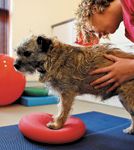Stretch to include rehabilitation services at your practice
Are you doing all you can to help veterinary patients recover from injuries and regain mobility?
Smart veterinary practice owners ask the question, "What's next for my hospital?" In 2010, Dr. Fred Metzger did just that.

Stand and deliver: A dog is examined on a balance ball.
Dr. Metzger, a Veterinary Economics Editorial Advisory Board member and owner of Metzger Animal Hospital in State College, Pa., realized that the time had come for his practice to offer full rehabilitation services. Dr. Metzger felt it was his responsibility to provide his clients and their pets with a new level of care.
He wasn't always so forward-thinking. In the early days of laser therapy, Dr. Metzger scoffed at the new technology. But after more research, he decided to try it. Four years ago, he bought a therapeutic laser and discovered its benefits for postoperative patients. "It's easy to use, has a small footprint, and really helps our patients," Dr. Metzger says. "I knew that the next step would be to install a full rehab center."
COULD REHAB WORK FOR YOUR PRACTICE?
Of course, before you add a service, it's important to figure out whether clients will use it. Because the team at Metzger Animal Hospital performs many orthopedic surgeries, potential rehabilitation patients were popping up every day. "We're fueling most of our own referrals from knee surgeries," Dr. Metzger says.
Dr. Metzger has also found success in marketing rehabilitation services to owners of agility and hunting dogs, which often suffer knee or leg injuries. "We see a lot of dogs that just can't run like they used to," he says. "Often it just takes a quick tune-up in our rehab center. I think we're going to see solid growth with this group in 2012."
EQUIP YOUR CLINIC AND YOUR TEAM
Adding rehabilitation services to your practice's offerings won't be cheap—particularly if you install an underwater treadmill, which can run $40,000 to $50,000 and requires plenty of space. Dr. Metzger built an 800-square-foot addition to his practice to house his rehabilitation center, and much of that space is dedicated to the treadmill. He also invested in a therapy laser, electrical stimulation equipment, ultrasonic therapy equipment, a standard treadmill, and therapeutic exercise equipment such as balance balls.
To make the most of your new service, Dr. Metzger says you'll want to seek certification for the team members who will operate the equipment. At Metzger Animal Hospital, one veterinarian is certified, along with a technician. The practice is also in the process of adding a physical therapist who recently became veterinary-certified. Dr. Metzger says this therapist will begin offering mobile rehabilitation services for clients who prefer not to travel to the practice. "I don't know anyone else who offers that service in our area," Dr. Metzger says.
FIND WAYS TO GROW
In addition to marketing rehab services on his practice's website, Dr. Metzger placed a photo of his underwater treadmill in his Yellow Pages ad. And while much of his business comes from his hospital's own surgical patients, Dr. Metzger plans to market rehabilitation services more aggressively toward nonsurgical patients in 2012. "We see a lot of older, geriatric dogs experiencing stiffness," he says. "Using treadmill therapy or massage therapy would be a great way to help these patients."
Still, Dr. Metzger maintains realistic expectations. Advanced rehabilitation services such as underwater treadmills won't be big moneymakers in most practices, he says, because the investment in equipment and training is steep. "But," he adds, "it gives us another alternative to help treat chronic conditions and avoid or decrease long-term medications like NSAIDs, and that's really cool. If I can break even with it, I'm happy."
Plus, he says, when clients work directly with rehabilitation therapists, they bond more tightly to the practice. "I like that," Dr. Metzger says. "Clients should be part of our extended veterinary family."